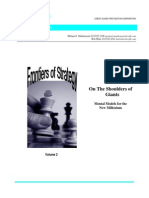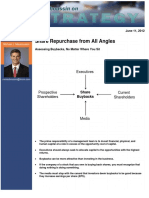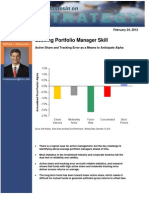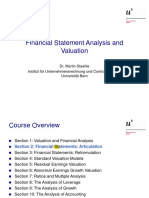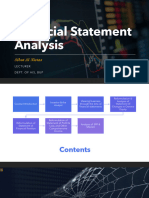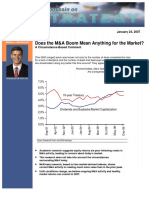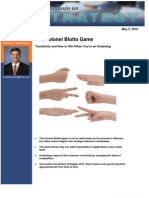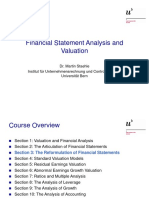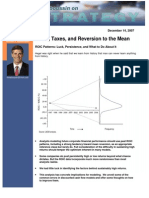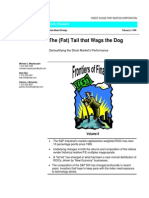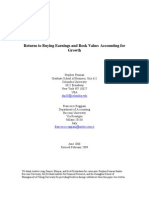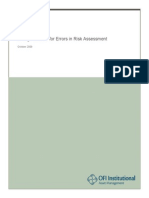Atoms, Bits, and Cash - The ABCs of Investing in The New Economy
Atoms, Bits, and Cash - The ABCs of Investing in The New Economy
Uploaded by
pjs15Copyright:
Available Formats
Atoms, Bits, and Cash - The ABCs of Investing in The New Economy
Atoms, Bits, and Cash - The ABCs of Investing in The New Economy
Uploaded by
pjs15Original Title
Copyright
Available Formats
Share this document
Did you find this document useful?
Is this content inappropriate?
Copyright:
Available Formats
Atoms, Bits, and Cash - The ABCs of Investing in The New Economy
Atoms, Bits, and Cash - The ABCs of Investing in The New Economy
Uploaded by
pjs15Copyright:
Available Formats
CREDIT SUISSE FIRST BOSTON CORPORATION
Equity Research
Americas U.S. Investment Strategy November 22, 1999
Atoms, Bits, and Cash
The ABCs of Investing in the New Economy
Michael J. Mauboussin
1 212 325 3108
michael.mauboussin@csfb.com
Stephen G. Kawaja
1 212 325 3922
stephen.kawaja@csfb.com
Detailed analysis of return on invested capital for the S&P 500
shows that the source of value creation is shifting from physical
capital to intellectual capitalfrom atoms to bits.
Given that our accounting system is poor at capturing intellectual
capital, investors must focus on the source of value creation:
cash.
We find that the cash conversion cycle is an excellent measure
of how well management is managing its tangible capital base.
Our data show that new economy industries are improving their
capital management better than old economy industries. Further,
companies closest to the customer tend to do a better job of
managing capital.
The cash conversion cycle is a great way for growth and value
investors to identify promise or trouble in their stock picks.
Atoms, Bits, and Cash
2
Table of Contents
Executive Summary............................................................................................. 3
Introduction.......................................................................................................... 4
The Digital Economy: From Atoms to Bits........................................................ 5
Not Accounting for Bits....................................................................................... 7
Uncovering Tangible Asset Efficiency 9
Capturing Change: The Cash Conversion Cycle............................................ 11
The Mechanics of the Cash Conversion Cycle 11
The Cash Conversion Cycle Applied............................................................... 13
The Economy 13
Various Sectors 13
Individual Companies 18
Case Study: Dell Computer Corp. 21
Appendix A......................................................................................................... 23
Appendix B......................................................................................................... 24
Atoms, Bits, and Cash
3
Executive Summary
Aggregate return on invested capital data mask some profound trends.
Detailed analysis of return on invested capital for the S&P 500 show that the
source of value creation is shifting from physical capital to intellectual capi-
talfrom atoms to bits. In fact, improved physical capital management has
freed roughly $245 billion over the past decade. However, measures of im-
proved physical capital management are offset by a surge in goodwill. Cash
is investings common denominator. Given that our accounting system is poor
at capturing intellectual capital, investors must focus on the source of value
creation: cash. There is a substantial and growing chasm between our ac-
counting system and economic reality. Analysis of cash flow shrinks that gap,
and allows investors to judge all companies on a universal and proven metric
of performance.
The cash conversion cycle is a powerful tool. We find that the cash conver-
sion cycle is an excellent measure of how well management is employing its
tangible capital base. In effect, an improving cash conversion cycle is often a
triumph of brains over brawnintellectual capital over physical capital.
Cash flow: out with the old, in with the new. Our data show that new economy
industriesincluding technology and communications servicesare improv-
ing their capital management better than old economy industries such as ba-
sic materials and energy. Further, companies closest to the customer tend to
do a better job of managing capital than those removed from the end market.
A stock pickers delight. The cash conversion cycle is a great tool for growth
and value investors to identify promise or trouble in their stock picks. Rising
cash conversion cycles often indicate deterioration in cash flows, while de-
clining cash conversion cycles generally signal improving cash flows. Neither
rising nor falling cash conversion cycles are readily apparent from the income
statement. Thus, changing cash conversion cycles are often a harbinger of
stock price performance.
Atoms, Bits, and Cash
4
Introduction
When I was a kid in the bank, the key economic indicator we looked at was
freight car loadings. Who cares about that now? What we need is a way to meas-
ure the knowledge we bring to the work we do.
-Walter Wriston
1
Throughout most of history, our economy has centered on the production of tan-
gible goods using physical assets. However, the economy is undergoing a fun-
damental shift. A new economy is emerging, where reliance on tangible capital is
yielding to intellectual capitalfrom atoms to bits. Intellectual capital is intellectual
materialknowledge, information, intellectual property, and experiencethat can
be put to use to create wealth.
2
This atoms-to-bits transformation has not only spawned whole new businesses, it
is reshaping the competitive landscape of traditional industries. It has also cre-
ated significant shareholder value, supporting one of the biggest and longest bull
markets in history.
Unfortunately, as ethereal bits eclipse concrete atoms, traditional financial meas-
ures become less reliable at capturing value. Our accounting system, designed to
track the movement of physical capital, is inelegant in recognizing knowledge
capital. The investment rules developed by Graham and Dodd for post-
Depression companies have little to say about intangible assets. But none of this
matters to the stock market, which clearly has rewarded brains over brawn.
Happily, there is a common denominator for valuing atoms and bits: cash. In fact,
Graham and Dodd were right all along: the value of a business is the present
value of future free cash flows. Debates about purchase versus pooling, expens-
ing versus capitalizing, and income statement versus balance sheet all overlook a
basic verity: the stock market follows cash. Increasingly, intellectual capital is re-
placing physical capitalfreeing huge sums of cash and confounding traditional
analysis.
This report is broken into four parts. First, we explore the shift from atoms to bits.
Our analysis reveals clear evidence of a surge in intellectual capital that is not
well captured in aggregate data. Second, we highlight the cash conversion cycle
as a useful starting point in identifying companies that are successfully replacing
tangible assets with intellectual capital. Third, we apply the cash conversion cycle
to various sectors and companies. This analysis highlights shifts in the economy
and provides critical insights about valuation. Finally, we show how the cash con-
version cycle can be a great tool for stock picking.
Atoms, Bits, and Cash
5
The Digital Economy: From Atoms to Bits
While the weight of current economic output is probably only modestly higher
than it was a half century ago, value added, adjusted for price change, has risen
well over threefold.
-Alan Greenspan
3
The Information Age is supplanting the Industrial Age. Knowledge is replacing
physical things as both the primary input and the final output of the production
process. The proof is everywhere, from radical new production processes to the
booming software industry.
4
Consider a beverage can. In 1958, Reynolds Metals developed a seven-ounce
aluminum can to compete with the standard steel can.
5
The new container
weighed a relatively hefty two-thirds of an ounce, and required costly chemicals
or massive amounts of expensive electric power to produce.
This all changed when aluminum producers and can manufacturers figured out
how to make the aluminum can into a viable alternative to the steel can. Improved
manufacturing know-how reduced the weight of the can to less than half an
ounce. The creation of an expansive recycling networkrecycled aluminum uses
about 5% of the electricity needed to make ingot out of scratchcircumvented
the massive power cost disadvantage. The technology took off.
By 1967, the year Coke and Pepsi started using the aluminum can, engineers
had figured out how to reduce the material used by more than 25%. Yet another
triumph of knowledge over nature.
Aluminum can production is a microcosm. For example, U.S. exports lost 50% of
their physical weight per dollar of value from 1990 to 1996.
6
The trend away from manufacturing and toward services and other nonphysical
output has become pronounced. In 1800, only 3% of the domestic workforce held
service jobs. By 1950, that number had jumped to 45%. We expect 70% of the
domestic workforce to hold service jobs by the turn of the millennium (see
Figure 1).
7
Atoms, Bits, and Cash
6
Figure 1
The Changing Economy
as a percentage of the domestic workforce
0%
10%
20%
30%
40%
50%
60%
70%
80%
90%
100%
1800 1850 1900 1950 2000E
%
o
f
T
o
t
a
l
U
.
S
.
E
m
p
l
o
y
m
e
n
t
Agriculture Manufacturing Services
Source: Myths of Rich and Poor, by W. Michael Cox and Richard Alm, and CSFB estimates.
All industries are affected by this shift. Moores Law predicts the doubling of com-
puting power every 18-24 months.
8
Gilders Law foretells the tripling of bandwidth
every year in the foreseeable future.
9
The continual shedding of mass and im-
provement in quality has spawned a generation of consumers that expects more
and more for less and less. And they are getting it.
Atoms, Bits, and Cash
7
Not Accounting for Bits
The good news is that theres a new item in the asset column, one youre prob-
ably not even accounting for: your information assets.
-Downes and Mui
10
Replacing capital with knowledge should manifest itself in a reduced asset base,
boosting commonly used return metrics such as return on operating assets. But,
as Figure 3 shows, this does not appear to be the case. A detailed analysis of the
S&P Industrials suggests that the world has not changed much in the past dec-
ade. Total operating return on assets is essentially the same as it was ten years
ago.
Figure 2
The Pretax Value Equation: Return on Operating Assets
"Operating Margin" "Asset Turns"
Operating Profit Sales
Sales Total Assets
Return on Operating Assets =
*
Source: CSFB.
Figure 3
Operating Return on Assets Unchanged since the End of the 1980s
S&P Industrials; in percent
7 . 0 %
7 . 5 %
8 . 0 %
8 . 5 %
9 . 0 %
9 . 5 %
1 0 . 0 %
1 0 . 5 %
1 1 . 0 %
1 2 / 9 8 1 2 / 9 7 1 2 / 9 6 1 2 / 9 5 1 2 / 9 4 1 2 / 9 3 1 2 / 9 2 1 2 / 9 1 1 2 / 9 0 1 2 / 8 9 1 2 / 8 8 1 2 / 8 7
Source: CSFB estimates, company financials, and FactSet.
In fact, if we dissect operating return on assets into its componentsoperating
margins and total asset turnswe still fail to find proof that bits have replaced
atoms. Actually, we see just the opposite: overall asset efficiency appears to have
deteriorated, with asset turns (sales/average total assets) falling from 1.04 in
1987 to 0.86 in 1998.
11
The apparent conclusion is that more assets are needed
to generate the same amount of revenue. So what gives?
Atoms, Bits, and Cash
8
Figure 4
Asset Turns Fall over the 1990s
S&P Industrials; in percent and turns
0.80
0.85
0.90
0.95
1.00
1.05
1.10
12/98 12/97 12/96 12/95 12/94 12/93 12/92 12/91 12/90 12/89 12/88 12/87
T
u
r
n
s
8.0%
8.5%
9.0%
9.5%
10.0%
10.5%
11.0%
11.5%
12.0%
M
a
r
g
i
n
Total Asset Turns Operating Margin
Source: CSFB estimates, company financials, and FactSet.
As it turns out, significant improvements in physical asset efficiency have been
masked by a substantial increase in goodwill. Goodwill is the residual between
the acquisition cost of a company and the sum of the fair values of all its identifi-
able assets and liabilities.
12
Our analysis of the S&P Industrials found that good-
will as a percentage of total assets jumped nearly 77% in the last eight years,
from 3.4% in 1990 to 6.0% in 1998. Goodwill as a percentage of sales rose from
3.6% in 1990 to 6.3% in 1998. The very existence of goodwill is recognition that
much of a companys assets are knowledge-based.
Further, these goodwill data are understated by the sizable write-offs taken in
recent years. R.G. Associates estimates that 1,369 special charges were taken or
announced during 1998 (charges for restructuring, in-process R&D, merger-
related items, and write-downs), representing $72.1 billion.
13
Figure 5
Goodwill Grows on Balance Sheets
S&P Industrials; in percent
2.5%
3.0%
3.5%
4.0%
4.5%
5.0%
5.5%
6.0%
6.5%
12/98 12/97 12/96 12/95 12/94 12/93 12/92 12/91 12/90 12/89
As a % of Total Assets As a % of Sales
Source: CSFB estimates, company financials, and FactSet.
Atoms, Bits, and Cash
9
Moreover, the surge in goodwill, while impressive, actually understates the rise in
intangible assets.
14
Reported goodwill results only from a merger or acquisition.
However, acquirors can choose to record transactions as either a purchase or a
pooling, with radically different accounting consequences.
15
Purchase account-
ing results in goodwill that is amortized, or expensed, against earnings for a pe-
riod of up to 40 years. In contrast, there is no goodwill entry for pooling deals. As
a result, a pooling deal leaves a company with a smaller asset base than a
purchase deal, even though the economics are identical.
16
So while an active market for corporate control has forced goodwill onto balance
sheets, goodwill is in no way a systematic or complete measure of intellectual
capital. In 1998 alone, 45.3% of the total domestic deal value was treated as a
pooling, leaving massive amounts of goodwill unreported.
Table 1
Chosen Accounting Convention for M&A Deals Announced in 1998
Total Value Number of Deals
(in millions) (in units)
Accounting Convention:
Domestic $1,996,279.9 14,801.0
Pooling 45.3% 3.8%
Purchase 54.7% 96.2%
Source: Security Data Corp.
Figure 6
Operating Return on Assets Does Not Explain Value
S&P Industrials; in percent and turns
0
200
400
600
800
1,000
1,200
1,400
1,600
12/98 12/97 12/96 12/95 12/94 12/93 12/92 12/91 12/90 12/89
P
r
i
c
e
6.0%
6.5%
7.0%
7.5%
8.0%
8.5%
9.0%
9.5%
10.0%
10.5%
11.0%
R
O
A
S&P Industrials ROA S&P Industrials Price
r
2
= 21.6%
Source: CSFB estimates, company financials, and FactSet.
Uncovering Tangible Asset Efficiency
Removing goodwill from the equation, we see that tangible asset efficiency is
actually soaring. Economy-wide productivity gains have reduced tangible asset
needs by more than $245 billion in the 1990s.
17
For the S&P Industrials, we see
that:
Net working capital as a percentage of sales fell, in aggregate, from 14.5% in
1990 to 11.4% in 1998. Had working capital efficiency remained at 1990 lev-
els, an additional $124 billion would be tied up in net working capital alone.
Net plant, property, and equipment enjoyed a similar, albeit more modest,
improvement over the decade. Net PPE as a percentage of sales fell from
Atoms, Bits, and Cash
10
37.1% in 1990 to 35.4% in 1998. Without improved efficiency, managers
would have been forced to inject an additional $121 billion into fixed assets.
Several catalysts have triggered this improvement.
Advances in technology. From software to computers to communications,
technology has provided the tools to better manage physical capital. Bar
codes allow close tracking of products at all stages, from inception to sale.
Point-of-sale scanners transmit up-to-the minute data to all participants in the
supply chain.
18
Enterprise and manufacturing resource-planning software
provides managers with unprecedented information about their businesses. A
myriad of management techniques have followed: just-in-time, total quality
management, quick response, efficient consumer response, demand flow,
and accurate response. As a result, supply chains have compressed to un-
precedented levels.
A shift in compensation systems. The adoption of value-based management
systems and compensation schemes has shifted managements focus to the
balance sheet. Compensation directly tied to asset efficiency provides a sig-
nificant incentive to improve performance.
Active market for corporate control. The robust M&A market has provided
further impetus for tighter corporate control. Investors look for opportunities to
exploit asset inefficiency. Managers who do not use their assets optimally risk
losing their company to a third party.
Figure 7
Fewer Tangible Assets Generated More Sales in the 1990s
S&P Industrials; as a percentage of sales
31%
32%
33%
34%
35%
36%
37%
38%
39%
40%
12/98 12/97 12/96 12/95 12/94 12/93 12/92 12/91 12/90 12/89
N
e
t
P
P
E
10%
11%
12%
13%
14%
15%
16%
N
e
t
W
o
r
k
i
n
g
C
a
p
i
t
a
l
Net PPE Net Working Capital
Source: CSFB estimates, company financials, and FactSet.
Atoms, Bits, and Cash
11
Capturing Change: The Cash Conversion Cycle
The cash conversion cycle is a powerful tool for assessing how well a company is
managing capital. It not only highlights the drivers of working capital, but also
sheds light on the dynamics of a supply chain. Interestingly, many industry supply
chains are being altered by information technology. These supply chains are
evolving from a system where goods are pushed from the vendor to the cus-
tomer to one where goods are pulled by the consumer through a responsive
chain. The result is reduced inventories, faster receivables collection, and ex-
tended payment terms with suppliers.
The Mechanics of the Cash Conversion Cycle
The cash conversion cycle quantifies the time between cash payment to suppliers
and cash receipt from customers.
The three components of the cash conversion cycle are:
19
Days sales outstanding (DSO).
20
The number of days between the sale of a
product and the receipt of a cash payment.
Days in inventory (DII).
21
The speed with which the stock of raw materials,
work in progress and finished goods of a company are converted into product
sales.
Days payables outstanding (DPO).
22
The number of days between the pur-
chase of an input from a vendor and cash payment to that vendor.
Figure 8
Components of the Cash Conversion Cycle
Days Payables Outstanding
Cash Conversion Cycle
Payment Received
Days in Inventory
Supplier Paid Customer Purchase Inventory Purchased
Days Sales Outstanding
Source: CSFB.
Investors should look for a pattern of short or shortening DSO and DII. Both in-
ventories and receivables tie up cashevery dollar freed from inventories or re-
ceivables translates into a one-time contribution to cash flow and a reduced need
for product financing through the supply chain.
23
Investors should look for a lengthening of days payables outstanding. The attrac-
tion of an account payable is similar to that of a charge card: enjoy the merchan-
dise now, pay later. Payables are a flexible and cheap form of financing, with
implicit sensitivity to product demand and order patterns.
Although payables lack explicit financing charges, the financing costs associated
with them are passed along in the cost of goods sold. Earlier payment is usually
rewarded with a discount that translates into higher margins. Thus, while late
payment is better on a cash basis, investors must monitor the movement in mar-
gins that accompanies extended terms.
Some businesses lengthen days payables outstanding beyond the days in in-
ventory and days sales outstanding combined, resulting in a negative cash con-
version cycle. This strategy turns working capital into a source of cash as
suppliers finance sales growth.
24
Increasingly, managements in both new and old
economy businesses are looking at lengthening payables as a way of boosting
the return on invested capital in their businesses.
Atoms, Bits, and Cash
12
In fact, Wal-Mart recently announced its objective: to sell merchandise before we
pay for it.
25
Currently, 63% of Wal-Marts inventory is sold before the bills are
paid, up from 55% in 1998. Wal-Mart expects its entire inventory to be financed
by suppliers within three years.
Atoms, Bits, and Cash
13
The Cash Conversion Cycle Applied
The Economy
As Figure 9 shows, the cash conversion cycle for the S&P 500
26
fell from
101.6 days in 1990 to 71.3 days in 1998, a 29.8% drop. This change suggests an
aggregate improvement in supply chain management. But, as we explain below,
the spoils have not accrued to all industries evenly.
Figure 9
S&P 500 Cash Conversion Cycle
in days
0
200
400
600
800
1,000
1,200
1,400
12/98 12/97 12/96 12/95 12/94 12/93 12/92 12/91 12/90
P
r
i
c
e
65
70
75
80
85
90
95
100
105
D
a
y
s
I
n
S&P 500 CCC S&P 500 Price
r
2
= 87.2%
Source: CSFB estimates, company financials, and FactSet.
Various Sectors
Two key trends emerge when we examine the sectors that compose the index.
First, within and across industries, position in the supply chain is critical in deter-
mining a firms cash conversion cycle. Companies closest to the consumer gen-
erally enjoy better cash economics. Many consumer businesses are cash and
carry, meaning that the typical 30- to 45-day terms extended in business-to-
business transactions are not required. Furthermore, an abundance of real-time
purchase information often gives these companies the ability to carry optimal lev-
els of inventory.
Atoms, Bits, and Cash
14
Figure 10
Sectors Closer to the Consumer Enjoy Better Cash Conversion Cycles
S&P 500; in days
Shortening
Lengthening
Closeness
to Customer
Energy
Basic
Materials
C
a
s
h
C
o
n
v
e
r
s
i
o
n
C
y
c
l
e
Capital
Goods
Technology
Health
Care
Consumer
Cyclicals
Communication
Services
Consumer
Staples
Far Near
Source: CSFB.
Second, companies that deal primarily with tangible output produced by physical
assets have been unable to enjoy the same improvements in cash conversion
cycles as those that deal in bits. For example, as Figure 10 highlights, the foun-
dation of the new economy, health care and technology, both posted impressive
improvements in their cash conversion cycles.
Specifics for each sector are as follows:
Communication services. Communication services companies posted the
largest decline in cash conversion cycles, from an average of 24.6 days in
1991 to an average of 8.9 days in the first two quarters of 1999. Days in in-
ventory were cut in half, falling from an average of 17.2 days in 1991 to an
average of 7.8 days in the first half of 1999.
Health care. Companies within the health care sector managed to reduce
their cash conversion cycle by 27.7% in the 1990s, from an average of 112.4
days in 1991 to an average of 81.2 days in the first half of 1999. A 19.6% re-
duction in days in inventory, from an average of 121.4 days in 1991 to an av-
erage of 97.7 days in the first two quarters of 1999, drove this reduction.
Technology. Technology companies cash conversion cycle fell from an aver-
age of 89.5 days in 1991 to an average of 67.6 days in the first two quarters
of 1999. Like the health care and communication services sectors, a 37.8%
decline in inventory, from an average of 82.0 days in 1991 to an average of
51.0 days in the first two quarters of 1999, fueled the decline.
Consumer cyclicals. Through aggressive management of terms, consumer
cyclicals companies cash conversion cycle fell 43.9%, from an average of
175.7 days in 1991 to an average of 98.5 days in the first half of 1999. While
days in inventory were actually slightly higher over the period, days sales
outstanding were halved, from an average of 177.4 in 1991 to an average of
88.7 in the first half of 1999.
Atoms, Bits, and Cash
15
Capital goods. Like consumer cyclicals, capital goods companies were able
to improve their cash conversion cycle primarily by better managing receiv-
ables. The sectors cash conversion cycle fell 23.2%, from an average of
118.0 days in 1991 to an average of 90.7 in the first two quarters of 1999.
Consumer staples. While the average cash conversion cycle in the sector
dropped a mere 12.6%, from an average of 48.3 in 1991 to 42.3 days in the
first two quarters of 1999, the absolute level is still less than half of its cyclical
counterpart.
Basic materials. The basic materials sector usually sits at the beginning of
the supply chain and deals in physical goods. Consequently, it is one of only
two sectors that actually showed a lengthening cash conversion cycle over
the 1990s. Both DSOs and DIIs lengthened, driving the cash conversion cy-
cle from an average of 73.7 days in 1991 to an average of 80.9 days in the
first half of 1999.
Energy. The energy sector posted the greatest lengthening in its cash con-
version cycle, jumping 34.9% in the 1990sfrom an average of 17.5 days in
1991 to an average of 23.6 days in the first two quarters of 1999.
Atoms, Bits, and Cash
16
Table 2
Cash Conversion Cycle by Sector
S&P 500 sector definitions; in days; percentage change
Average 1991
Average
year-to-date 1999
Change Average 1991
Average
year-to-date 1999
Change
Communication Services Basic Materials
Days: Sales Outstanding 64.93 65.70 1.19% Days: Sales Outstanding 53.82 56.28 4.58%
in Inventory 17.19 7.80 (54.61%) in Inventory 63.17 65.05 2.97%
Payables Outstanding 57.52 64.56 12.24% Payables Outstanding 43.24 40.44 (6.49%)
CCC 24.60 8.94 (63.6)% CCC 73.74 80.89 9.7%
Consumer Cyclicals Energy
Days: Sales Outstanding 177.38 88.72 (49.98%) Days: Sales Outstanding 36.76 42.29 15.03%
in Inventory 57.09 57.92 1.46% in Inventory 27.88 24.65 (11.60%)
Payables Outstanding 58.81 48.14 (18.13%) Payables Outstanding 47.18 43.38 (8.06%)
CCC 175.66 98.50 (43.9)% CCC 17.46 23.56 34.9%
Health Care
Days: Sales Outstanding 61.74 60.28 (2.36%)
in Inventory 121.45 97.48 (19.74%)
Payables Outstanding 72.13 76.84 6.52%
CCC 111.05 80.92 (27.1)%
Technology
Days: Sales Outstanding 89.54 70.06 (21.75%)
in Inventory 81.98 51.48 (37.21%)
Payables Outstanding 82.00 52.08 (36.49%)
CCC 89.53 69.47 (22.4)%
Capital Goods
Days: Sales Outstanding 93.11 72.41 (22.23%)
in Inventory 69.79 63.00 (9.72%)
Payables Outstanding 44.90 44.75 (0.33%)
CCC 118.00 90.66 (23.2)%
Consumer Staples
Days: Sales Outstanding 30.40 30.44 0.12%
in Inventory 61.36 55.97 (8.77%)
Payables Outstanding 43.28 44.07 1.84%
CCC 48.49 42.34 (12.7)%
Improved Lagged
Source: CSFB estimates, company financials, and FactSet.
Atoms, Bits, and Cash
17
Table 3
Longest and Shortest Cash Conversions by Sector
S&P 500 sector definitions; in days; percentage change
Sector
Ticker Name Jun-99 Ticker Name Jun-99
Basic Materials ABX BARRICK GOLD CORP COM (12.1) SIAL SIGMA ALDRICH CORP COM 318.7
PDG PLACER DOME INC COM 21.8 PHB PIONEER HI BRED INTL INC COM 308.8
EMN EASTMAN CHEMICAL CO COM 23.3 MTC MONSANTO CO COM 229.2
LPX LOUISIANA PAC CORP COM 28.8 IFF INTL FLAVORS FRAGRANCE COM 223.9
CHA CHAMPION INTL CORP COM 29.1 GLK GREAT LAKES CHEM CORP COM 142.1
Capital Goods JCI JOHNSON CTLS INC COM 15.1 DE DEERE & CO COM 313.8
WMI WASTE MGMT INC DEL COM 22.9 CSE CASE CORP COM 238.3
FLR FLUOR CORP COM 23.2 PLL PALL CORP COM 213.9
ETN EATON CORP COM 33.2 TXT TEXTRON INC COM 201.4
IR INGERSOLL RAND CO COM 34.7 IIN ITT INDS INC IND COM 177.6
Consumer Cyclicals DJ DOW JONES & CO INC COM (32.4) F FORD MOTOR CO DEL COM 298.7
CCL CARNIVAL CORP COM (9.5) SNA SNAP ON INC COM 211.4
CNS CONSOLIDATED STORES CORP COM (7.1) KBH KAUFMAN & BROAD HOME COM 202.3
MIR MIRAGE RESORTS INC COM (3.7) RML RUSSELL CORP COM 193.8
TRB TRIBUNE CO NEW COM (0.0) FTL FRUIT OF THE LOOM LTD ORD CL A 184.5
Consumer Staples CMCSK COMCAST CORP CL A SPL (73.8) UST U S T INC COM 328.4
YUM TRICON GLOBAL RESTAURANTS COM (46.5) BF.B BROWN FORMAN CORP CL B 216.4
CCE COCA COLA ENTERPRISES INC COM (15.2) FO FORTUNE BRANDS INC COM 168.0
DIS DISNEY WALT COMPANY COM (3.5) G GILLETTE CO COM 167.0
MCD MCDONALDS CORP COM (1.2) NWL NEWELL RUBBERMAID INC COM 128.1
Energy APC ANADARKO PETE CORP COM (20.5) RDC ROWAN COS INC COM 129.0
XON EXXON CORP COM 3.0 BHI BAKER HUGHES INC COM 109.4
BR BURLINGTON RES INC COM 9.1 HAL HALLIBURTON CO COM 69.2
UCL UNOCAL CORP COM 14.2 HP HELMERICH & PAYNE INC COM 65.2
P PHILLIPS PETE CO COM 14.6 KMG KERR-MCGEE CORP COM 61.7
Health Care WLA WARNER LAMBERT CO COM (21.1) BMET BIOMET INC COM 382.1
MRK MERCK & CO INC COM 15.9 AHP AMERICAN HOME PRODS CORP COM 236.6
SGP SCHERING PLOUGH CORP COM 16.8 PFE PFIZER INC COM 235.4
COL COLUMBIA/HCA HEALTHCARE CORP COM 24.8 BOL BAUSCH & LOMB INC COM 193.5
HCR HCR MANOR CARE INC COM 36.8 BCR BARD C R INC COM 189.5
Technology ADBE ADOBE SYS INC COM (97.8) KLAC KLA-TENCOR CORP COM 261.1
MSFT MICROSOFT CORP COM (83.4) XRX XEROX CORP COM 225.9
DELL DELL COMPUTER CORP COM (10.9) ANDW ANDREW CORP COM 171.0
NOVL NOVELL INC COM (8.4) LU LUCENT TECHNOLOGIES INC COM 143.5
GTW GATEWAY INC COM (4.8) PRD POLAROID CORP COM 139.0
Cash Conversion Cycle (in days)
Shortest Longest
Source: CSFB estimates, company financials, and FactSet.
Atoms, Bits, and Cash
18
Individual Companies
The cash conversion cycle is a robust tool when applied to individual companies.
Overall, there is a remarkable correspondence between capital market valuation
and a short cash conversion cycle.
First, the difference between individual companies across sectors is striking. For
example, Microsoft, an icon of the Information Age, had a negative 83.0-day cash
conversion cycle and traded at 83.1 times noncash assets at its 1999 fiscal year-
end. On the same day, Exxon, the worlds largest oil company, had a negative
0.7 day cash conversion cycle and traded at 2.1 times its noncash assets.
Figure 11
Asset Values and Market Values Diverge in the New Economy
in millions; ratios in units
Exxon Corp. Microsoft Corp.
For the quarter ended 6/30/99 For the quarter ended 6/30/99
Days In: Days In:
Sales 28.37 Sales 35.05
Inventory 15.52 Inventory 0.00
Payables 44.54 Payables 117.58
CCC: (0.65) CCC: (82.52)
Partial Balance Sheet - excluding cash & investments Partial Balance Sheet - excluding cash & investments
in millions in millions
Assets 6/30/99 Assets 6/30/99
Current Assets Current Assets
Accounts receivable 9,107 Accounts receivable 2,245
Inventories 4,787 Inventories 0
Other current assets 1,187 Other current assets 752
Total current assets 15,081 Total current assets 2,997
Property and equipment 65,002 Property and equipment 1,611
Other assets 9,804 Other assets 940
74,806 2,551
Total Operating Assets 89,887 Total Operating Assets 5,548
Market Capitalization Market Capitalization
Share price 77.13 $ Share price 90.19 $
Shares outstanding 2,428 Shares outstanding 5,109
187,259.50 $ 460,767.94 $
Market Capitalization / Operating Assets 2.08 Market Capitalization / Operating Assets 83.05
Note: annualized quarterly data.
Source: Company financials.
Second, even within a traditional industry such as steel, we see serious valuation
mismatches based on different cash conversion cycles. Steel was the quintes-
sential manufactured product of the early Twentieth Century. Once, sheer brawn
added most of the value in the production of steelextracting the ore, shipping it
to the mills, and the like. Now, the revolutionary application of intellectual capital
to the production process makes brains more important than brawn. Bethlehem
Steel once required three to four man-hours of labor to make a ton of steel. To-
day, Nucor Steel can process the same ton in 45 minutes. This substitution of bits
for atoms is immediately apparent in the cash conversion cycle.
27
Atoms, Bits, and Cash
19
Figure 12
The Market Values Intellectual Capital
in millions; ratios in units
Bethlehem Steel Corp. Nucor Corp.
For the quarter ended 6/30/99 For the quarter ended 7/3/99
Days In: Days In:
Sales 26.48 Sales 30.89
Inventory 90.13 Inventory 39.09
Payables 35.38 Payables 21.69
CCC: 81.22 CCC: 48.29
Partial balance Sheet - excluding cash, investments and discontinued operations Partial Balance Sheet - excluding cash & investments
in millions in millions
Assets 6/30/99 Assets 7/3/99
Current Assets Current Assets
Accounts receivable 290 Accounts receivable 342
Inventories 980 Inventories 384
Other current assets 6 Other current assets 87
Total current assets 1,276 Total current assets 814
Property and equipment 2,748 Property and equipment 2,093
Other assets 1,284
4,032 2,093
Total Operating Assets 5,309 Total Operating Assets 2,907
Market Capitalization Market Capitalization
Share price 7.69 $ Share price 48.94 $
Shares outstanding 131 Shares outstanding 87
1,005.53 $ 4,272.24 $
Market Capitalization / Operating Assets 0.19 Market Capitalization / Operating Assets 1.47
Note: annualized quarterly data.
Source: Company financials.
Third, different cash conversion cycles are apparent between the old and new
economy business model within particular industries.
Figure 13
Companies with Negative Cash Conversion Cycles are Rewarded
in millions; ratios in units
Compaq Computer Corp. Dell Computer Corp.
For the quarter ended 6/30/99 For the quarter ended 7/30/99
Days In: Days In:
Sales 62.64 Sales 35.52
Inventory 26.75 Inventory 6.32
Payables 49.93 Payables 56.52
CCC: 39.45 CCC: (14.69)
Partial Balance Sheet - excluding cash & investments Partial Balance Sheet - excluding cash & investments
in millions in millions
Assets 6/30/99 Assets 7/30/99
Current Assets Current Assets
Accounts receivable 6,556 Accounts receivable 2,424
Inventories 2,224 Inventories 336
Other current assets 1,833 Other current assets 588
Total current assets 10,613 Total current assets 3,348
Property and equipment 3,018 Property and equipment 601
Other assets 5,939 Other assets 44
8,957 645
Total Operating Assets 19,570 Total Operating Assets 3,993
Market Capitalization Market Capitalization
Share price 23.69 $ Share price 40.88 $
Shares outstanding 1,693 Shares outstanding 2,540
40,102.94 $ 103,822.50 $
Market Capitalization / Operating Assets 2.05 Market Capitalization / Operating Assets 26.00
Note: annualized quarterly data.
Source: Company financials.
Finally, tracking a companys cash conversion cycle gives the best assessment of
the dynamic capital needs of a business, making the measure a useful in antici-
pating stock price performance. The following case study illustrates this point.
Atoms, Bits, and Cash
20
Dell Computer Corp.
The balance between profitable growth and liquidity management is all about
velocity.
Thomas Meredith, Chief Financial Officer, Dell Computer Corp.
28
On January 3, 1995, Dells stock fetched $0.623 per (split-adjusted) share. By
June 30, 1999, Dell stock traded at $37.00 per share, almost sixty times the ear-
lier value.
Over the period, Dell management made a deliberate effort to break out all inter-
nal activities into their operational components, isolating the essential drivers of
return on invested capital. This process highlighted the importance of working
capital requirements on invested capital totals.
Through the implementation of the direct model (build to order) and fast receiv-
ables collection, the company actually turned working capital into a source of
cash. Dells return on invested capital went from 37% in 1995 to 195% in 1998.
Because so much of Dells invested capital was tied up in working capital, we
estimate that without the improvements in the cash conversion cycle, Dells return
on investment would be roughly two-thirds its current level.
The effective management of these assets over the period led to a dramatic rise
in market value.
Figure 14
Dells Shortening CCC Translates into Market Value
in millions; ratios in units
(20)
(10)
0
10
20
30
40
50
4/99 10/98 4/98 10/97 4/97 10/96 4/96 10/95 4/95
I
n
d
a
y
s
0
10
20
30
40
50
60
70
80
R
e
l
a
t
i
v
e
P
r
i
c
e
Cash Conversion Cycle Relative Price
Source: Company financials, disclosure, and FactSet.
Conclusion
The economy is in transition. As intellectual capital sucks tangible capital from
businesses, cash is freed. We believe the cash conversion cycle allows investors
to better pick winners in this New Economy.
Atoms, Bits, and Cash
21
N.B.: CREDIT SUISSE FIRST BOSTON CORPORATION may have, within the last three years, served as a manager
or co-manager of a public offering of securities for or makes a primary market in issues of any or all of the companies
mentioned. Closing prices are as of November 18, 1999.
ALCOA INC (AA, 62.6875) CARDINAL HEALTH INC (CAH, 50) FREEPRT MCMOR COP&GLD -CL B (FCX, 16.875)
APPLE COMPUTER INC (AAPL, 90.25) CATERPILLAR INC (CAT, 55.375) FEDERATED DEPT STORES (FD, 41.4375)
ALBERTSONS INC (ABS, 36.5) COOPER INDUSTRIES INC (CBE, 44.1875) FIRST DATA CORP (FDC, 45.4375)
ABBOTT LABORATORIES (ABT, 37.3125) CBS CORP (CBS, 53.75) FORT JAMES CORP (FJ, 27.9375)
BARRICK GOLD CORPORATION (ABX, 17.625) CIRCUIT CITY STR CRCT CTY GP (CC, 45.375) FLEETWOOD ENTERPRISES (FLE, 22.25)
ARMSTRONG WORLD INDS INC (ACK, 35.6875) COCA-COLA ENTERPRISES (CCE, 21.9375) FLUOR CORP (FLR, 38.5)
ALBERTO-CULVER CO -CL B (ACV, 24.1875) CROWN CORK & SEAL CO INC (CCK, 21.875) FMC CORP (FMC, 48.1875)
ADOBE SYSTEMS INC (ADBE, 75) CARNIVAL CORP (CCL, 49.5625) FORTUNE BRANDS INC (FO, 33.25)
ADC TELECOMMUNICATIONS INC (ADCT, 51) CLEAR CHANNEL COMMUNICATIONS (CCU, 85.5625) SPRINT FON GROUP (FON, 74.0625)
ARCHER-DANIELS-MIDLAND CO (ADM, 14.125) CENDANT CORP (CD, 14.5625) FRUIT OF THE LOOM LTD -CL A (FTL, 2.875)
AUTODESK INC (ADSK, 20.9375) CERIDIAN CORP (CEN, 21.8125) FOSTER WHEELER CORP (FWC, 11.125)
AETNA INC (AET, 60.625) CHAMPION INTERNATIONAL CORP (CHA, 61.9375) GILLETTE CO (G, 36)
ALLERGAN INC (AGN, 107.4375) CHEVRON CORP (CHV, 96.5625) GREAT ATLANTIC & PAC TEA CO (GAP, 26.9375)
AMERADA HESS CORP (AHC, 62.9375) COLGATE-PALMOLIVE CO (CL, 57.375) GANNETT CO (GCI, 72.1875)
AMERICAN HOME PRODUCTS CORP (AHP, 52.4375) CLOROX CO/DE (CLX, 49) GENERAL DYNAMICS CORP (GD, 53.4375)
AMERITECH CORP (AIT, 68.25) COMCAST CORP -CL A SPL (CMCSK, 46.75) GUIDANT CORP (GDT, 56)
ALCAN ALUMINIUM LTD (AL, 33.0625) CONSOLIDATED STORES CORP (CNS, 20.25) GENERAL ELECTRIC CO (GE, 141.1875)
ALLIEDSIGNAL INC (ALD, 60.8125) CONOCO INC (COC.B, 28.375) GENERAL INSTRUMENT CORP (GIC, 66.25)
ALLEGHENY TELEDYNE INC (ALT, 15.125) COLUMBIA/HCA HLTHCR -VTG (COL, 27.125) GENERAL MILLS INC (GIS, 40.3125)
AMERICAN GREETINGS -CL A (AM, 25.3125) 3COM CORP (COMS, 38.5) GREAT LAKES CHEMICAL CORP (GLK, 34.625)
APPLIED MATERIALS INC (AMAT, 110) COSTCO WHOLESALE CORP (COST, 86.0625) CORNING INC (GLW, 95.375)
ADVANCED MICRO DEVICES (AMD, 26.6875) CAMPBELL SOUP CO (CPB, 46.5) GENERAL MOTORS CORP (GM, 71.0625)
AMGEN INC (AMGN, 91.125) COMPAQ COMPUTER CORP (CPQ, 23.5625) GEORGIA-PACIFIC GROUP (GP, 42.9375)
ANDREW CORP (ANDW, 15.25) COMPUWARE CORP (CPWR, 32.75) GENUINE PARTS CO (GPC, 26.5)
AMERICA ONLINE INC (AOL, 156) CRANE CO (CR, 17.4375) GAP INC (GPS, 38.375)
APACHE CORP (APA, 43.375) CABLETRON SYSTEMS (CS, 23) GOODRICH (B F) CO (GR, 22.9375)
ANADARKO PETROLEUM CORP (APC, 35.4375) COMPUTER SCIENCES CORP (CSC, 62.125) GRACE (W R) & CO (GRA, 14.0625)
AIR PRODUCTS & CHEMICALS INC (APD, 33.625) CISCO SYSTEMS INC (CSCO, 84.75) GOODYEAR TIRE & RUBBER CO (GT, 38.5)
ASARCO INC (AR, 29.6875) CASE CORP (CSE, 54.8125) GTE CORP (GTE, 76.6875)
ATLANTIC RICHFIELD CO (ARC, 97.5) COOPER TIRE & RUBBER (CTB, 16.5) GATEWAY INC (GTW, 77.875)
ASHLAND INC (ASH, 35.6875) CENTURYTEL INC (CTL, 43.6875) GRAINGER (W W) INC (GWW, 45.4375)
ALLTEL CORP (AT, 85.625) CENTEX CORP (CTX, 28.125) HARCOURT GENERAL INC (H, 36.1875)
AUTOMATIC DATA PROCESSING (AUD, 50.6875) CUMMINS ENGINE (CUM, 42.3125) HALLIBURTON CO (HAL, 44.125)
AVON PRODUCTS (AVP, 28.8125) CVS CORP (CVS, 40.375) HASBRO INC (HAS, 23.25)
AVERY DENNISON CORP (AVY, 62) CYPRUS AMAX MINERALS CO (CYM, 19) MANOR CARE INC (HCR, 20.375)
ALLIED WASTE INDS INC (AW, 8) DANA CORP (DCN, 26.75) HOME DEPOT INC (HD, 79.9375)
ALZA CORP (AZA, 42.8125) DU PONT (E I) DE NEMOURS (DD, 62.25) HARRAHS ENTERTAINMENT INC (HET, 27.8125)
AUTOZONE INC (AZO, 29.8125) DILLARDS INC -CL A (DDS, 19.3125) HILTON HOTELS CORP (HLT, 9.3125)
BOEING CO (BA, 42.5625) DEERE & CO (DE, 39.75) HOMESTAKE MINING (HM, 8.375)
BAXTER INTERNATIONAL INC (BAX, 67.625) DELL COMPUTER CORP (DELL, 39.75) HEINZ (H J) CO (HNZ, 42.5625)
BEST BUY CO INC (BBY, 51.125) DOLLAR GENERAL (DG, 24.75) HONEYWELL INC (HON, 112.625)
BRUNSWICK CORP (BC, 23.625) DATA GENERAL CORP (DGN, 22.25) HELMERICH & PAYNE (HP, 27.4375)
BOISE CASCADE CORP (BCC, 38.8125) DAYTON HUDSON CORP (DH, 62.3125) HERCULES INC (HPC, 25.875)
BARD (C.R.) INC (BCR, 55.8125) DANAHER CORP (DHR, 51.375) BLOCK H & R INC (HRB, 49)
BLACK & DECKER CORP (BDK, 48.9375) DISNEY (WALT) COMPANY (DIS, 26) HEALTHSOUTH CORP (HRC, 5.875)
BECTON DICKINSON & CO (BDX, 29.6875) DOW JONES & CO INC (DJ, 61.625) HARRIS CORP (HRS, 20.0625)
BELL ATLANTIC CORP (BEL, 65.1875) DELUXE CORP (DLX, 25.5) HERSHEY FOODS CORP (HSY, 51.625)
BROWN-FORMAN -CL B (BF.B, 66.6875) DUN & BRADSTREET CORP (DNB, 27.75) HUMANA INC (HUM, 7.4375)
BESTFOODS (BFO, 58.25) DONNELLEY (R R) & SONS CO (DNY, 24.0625) HEWLETT-PACKARD CO (HWP, 78)
BRIGGS & STRATTON (BGG, 57) DOVER CORP (DOV, 44.5625) INTL BUSINESS MACHINES CORP (IBM, 93.25)
BAKER-HUGHES INC (BHI, 29.125) DOW CHEMICAL (DOW, 122.5) INTL FLAVORS & FRAGRANCES (IFF, 38.3125)
BALL CORP (BLL, 39.5) DELPHI AUTOMOTIVE SYS CORP (DPH, 16.25) ITT INDUSTRIES INC (IIN, 34.375)
BELLSOUTH CORP (BLS, 44.8125) DARDEN RESTAURANTS INC (DRI, 19.375) IKON OFFICE SOLUTIONS (IKN, 6.9375)
BMC SOFTWARE INC (BMCS, 69.5) ENGELHARD CORP (EC, 17.3125) INTEL CORP (INTC, 74.75)
BIOMET INC (BMET, 34.1875) ECOLAB INC (ECL, 37.625) INTL PAPER CO (IP, 54.9375)
BEMIS CO (BMS, 34.25) ELECTRONIC DATA SYSTEMS CORP (EDS, 63.4375) INTERPUBLIC GROUP OF COS (IPG, 44.5)
BRISTOL MYERS SQUIBB (BMY, 75.875) EQUIFAX INC (EFX, 26.0625) INGERSOLL-RAND CO (IR, 52)
BAUSCH & LOMB INC (BOL, 59.4375) PERKINELMER INC (EGG, 42) ILLINOIS TOOL WORKS (ITW, 67.125)
BURLINGTON RESOURCES INC (BR, 39) EASTMAN KODAK CO (EK, 66.625) JOHNSON CONTROLS INC (JCI, 58.8125)
BETHLEHEM STEEL CORP (BS, 6.375) EMC CORP/MA (EMC, 83.1875) PENNEY (J C) CO (JCP, 22.3125)
BOSTON SCIENTIFIC CORP (BSX, 21.8125) EASTMAN CHEMICAL CO (EMN, 38.875) JOHNSON & JOHNSON (JNJ, 105.625)
ANHEUSER-BUSCH COS INC (BUD, 75.3125) EMERSON ELECTRIC CO (EMR, 57.75) JOSTENS INC (JOS, 19.8125)
COMPUTER ASSOCIATES INTL INC (CA, 62.1875) EATON CORP (ETN, 79.3125) NORDSTROM INC (JWN, 22.375)
CONAGRA INC (CAG, 25.625) FORD MOTOR CO (F, 52.625) KELLOGG CO (K, 36)
Atoms, Bits, and Cash
22
KAUFMAN & BROAD HOME CORP (KBH, 25.0625) OWENS-ILLINOIS INC (OI, 24.25) SYSCO CORP (SYY, 39.75)
KLA-TENCOR CORP (KLAC, 91.1875) OMNICOM GROUP (OMC, 90.875) AT&T CORP (T, 47.3125)
K MART CORP (KM, 9.375) ORACLE CORP (ORCL, 71) TANDY CORP (TAN, 66.3125)
KIMBERLY-CLARK CORP (KMB, 68.0625) OWENS CORNING (OWC, 18.1875) TEKTRONIX INC (TEK, 32.5625)
KERR-MCGEE CORP (KMG, 60.5) OCCIDENTAL PETROLEUM CORP (OXY, 23.75) TENNECO AUTOMOTIVE INC (TEN, 7.1875)
COCA-COLA CO (KO, 59.9375) PHILLIPS PETROLEUM CO (P, 51.375) TENET HEALTHCARE CORP (THC, 24)
KROGER CO (KR, 23.1875) PAYCHEX INC (PAYX, 41.5) TEMPLE-INLAND INC (TIN, 63.75)
KNIGHT-RIDDER INC (KRI, 58.5) PITNEY BOWES INC (PBI, 49.8125) TJX COMPANIES INC (TJX, 22.9375)
KOHLS CORP (KSS, 71.9375) PEP BOYS-MANNY MOE & JACK (PBY, 9.75) TIMKEN CO (TKR, 19)
KING WORLD PRODUCTIONS INC (KWP, 42.25) PACCAR INC (PCAR, 42.25) TELLABS INC (TLAB, 73.625)
LONGS DRUG STORES INC (LDG, 27) POTLATCH CORP (PCH, 44.125) TIMES MIRROR COMPANY -SER A (TMC, 67.8125)
LAIDLAW INC (LDW, 5.8125) SPRINT PCS GROUP (PCS, 89.6875) THERMO ELECTRON CORP (TMO, 13.6875)
LIZ CLAIBORNE INC (LIZ, 38.375) PHELPS DODGE CORP (PD, 54.625) THOMAS & BETTS CORP (TNB, 44.8125)
LILLY (ELI) & CO (LLY, 75.0625) PLACER DOME INC (PDG, 11.75) TOYS R US INC (TOY, 17.75)
LOCKHEED MARTIN CORP (LMT, 19.25) PE CORP (PEB, 80.5625) TRIBUNE CO (TRB, 53.5)
LOWES COS (LOW, 55) PEPSICO INC (PEP, 34.125) TRW INC (TRW, 52.625)
LOUISIANA-PACIFIC CORP (LPX, 12.8125) PFIZER INC (PFE, 33.8125) TUPPERWARE CORP (TUP, 18.875)
LSI LOGIC CORP (LSI, 61.75) PROCTER & GAMBLE CO (PG, 109) TIME WARNER INC (TWX, 67.5)
LIMITED INC (LTD, 38.6875) PARKER-HANNIFIN CORP (PH, 47.875) TEXACO INC (TX, 65.375)
LUCENT TECHNOLOGIES INC (LU, 76.75) PIONEER HI-BRED INTERNATIONL (PHB, 39.9375) TEXAS INSTRUMENTS INC (TXN, 94.9375)
LEXMARK INTL GRP INC -CL A (LXK, 78.625) PULTE CORP (PHM, 21.5625) TEXTRON INC (TXT, 73.5)
MARRIOTT INTL INC (MAR, 33.5) PALL CORP (PLL, 24.3125) TYCO INTERNATIONAL LTD (TYC, 44.25)
MASCO CORP (MAS, 28.75) PARAMETRIC TECHNOLOGY CORP (PMTC, 22) UNOCAL CORP (UCL, 35.3125)
MATTEL INC (MAT, 13.4375) PHARMACIA & UPJOHN INC (PNU, 58.75) UNISYS CORP (UIS, 24.6875)
MAY DEPARTMENT STORES CO (MAY, 32.25) PPG INDUSTRIES INC (PPG, 60.5) UNION CARBIDE CORP (UK, 61.5625)
MCDONALDS CORP (MCD, 46.125) POLAROID CORP (PRD, 19.9375) MEDIAONE GROUP INC (UMG, 71.125)
MCKESSON HBOC INC (MCK, 23.5) PEOPLESOFT INC (PSFT, 18.5) UNILEVER N V -NY SHARES (UN, 56.1875)
MEREDITH CORP (MDP, 39.625) PRAXAIR INC (PX, 47.9375) UNITED HEALTHCARE CORP (UNH, 56.375)
MCDERMOTT INTL INC (MDR, 9.6875) QUALCOMM INC (QCOM, 342.875) UNION PACIFIC RESOURCES GRP (UPR, 15.875)
MEDTRONIC INC (MDT, 39) RITE AID CORP (RAD, 6.625) UST INC (UST, 26.875)
MEAD CORP (MEA, 39.1875) RALSTON PURINA CO (RAL, 31.3125) U S WEST INC (USW, 65.125)
MCGRAW-HILL COMPANIES (MHP, 59.375) REEBOK INTERNATIONAL LTD (RBK, 9) UNITED TECHNOLOGIES CORP (UTX, 56.375)
MILLIPORE CORP (MIL, 34.3125) ROYAL DUTCH PET -NY REG (RD, 64.6875) VF CORP (VFC, 30)
MIRAGE RESORTS INC (MIR, 12.5) ROWAN COS INC (RDC, 18.4375) VIACOM INC -CL B (VIA.B, 52.75)
MALLINCKRODT INC (MKG, 35.375) COORS (ADOLPH) -CL B (RKY, 52.125) VULCAN MATERIALS CO (VMC, 42.4375)
MINNESOTA MINING & MFG CO (MMM, 101.5) REYNOLDS METALS CO (RLM, 61.625) SEAGRAM CO LTD (VO, 44.3125)
PHILIP MORRIS COS INC (MO, 25.9375) RUSSELL CORP (RML, 13.9375) WESTVACO CORP (W, 31.875)
MOBIL CORP (MOB, 105.3125) ROHM & HAAS CO (ROH, 37.375) WALGREEN CO (WAG, 28.75)
MOTOROLA INC (MOT, 119) ROCKWELL INTL CORP (ROK, 47.1875) MCI WORLDCOM INC (WCOM, 88.5)
MERCK & CO (MRK, 77.25) RAYTHEON CO -CL B (RTN.B, 31.375) WENDYS INTERNATIONAL INC (WEN, 23.75)
USX-MARATHON GROUP (MRO, 29.8125) IMS HEALTH INC (RX, 26.875) WHIRLPOOL CORP (WHR, 65.4375)
MICROSOFT CORP (MSFT, 85) SEARS ROEBUCK & CO (S, 31.3125) WINN-DIXIE STORES INC (WIN, 28.1875)
MONSANTO CO (MTC, 45.5625) SBC COMMUNICATIONS INC (SBC, 51.625) WARNER-LAMBERT CO (WLA, 88.6875)
MICRON TECHNOLOGY INC (MU, 63.625) SEALED AIR CORP (SEE, 52.4375) WILLAMETTE INDUSTRIES (WLL, 45.6875)
MAYTAG CORP (MYG, 45.625) SEAGATE TECHNOLOGY (SEG, 35.9375) WELLPOINT HLTH NETWRK -CL A (WLP, 66.875)
MILACRON INC (MZ, 15.1875) SCIENTIFIC-ATLANTA INC (SFA, 57.5625) WASTE MANAGEMENT INC (WMI, 16.1875)
INCO LTD (N, 19.5) SILICON GRAPHICS INC (SGI, 8.3125) WAL-MART STORES (WMT, 58.875)
NAVISTAR INTERNATIONL (NAV, 38) SCHERING-PLOUGH (SGP, 56.875) WATSON PHARMACEUTICALS INC (WPI, 37.3125)
NACCO INDUSTRIES -CL A (NC, 48) SHERWIN-WILLIAMS CO (SHW, 21.375) WORTHINGTON INDUSTRIES (WTHG, 15.6875)
NEWMONT MINING CORP (NEM, 21.9375) SIGMA-ALDRICH (SIAL, 28.3125) WRIGLEY (WM) JR CO (WWY, 84.1875)
NABISCO GROUP HLDGS CORP (NGH, 12) SCHLUMBERGER LTD (SLB, 68.8125) WEYERHAEUSER CO (WY, 62.4375)
NIKE INC -CL B (NKE, 44.25) SARA LEE CORP (SLE, 26) USX-U S STEEL GROUP (X, 24.625)
NORTHROP GRUMMAN CORP (NOC, 55.375) SOLECTRON CORP (SLR, 85.5) EXXON CORP (XON, 80.25)
NOVELL INC (NOVL, 23) SPRINGS INDUSTRIES -CL A (SMI, 40.125) XEROX CORP (XRX, 24.875)
NATIONAL SERVICE INDS INC (NSI, 31.8125) SHARED MEDICAL SYSTEMS CORP (SMS, 40.625) TRICON GLOBAL RESTAURANTS (YUM, 42.3125)
NATIONAL SEMICONDUCTOR CORP (NSM, 35.8125) SNAP-ON INC (SNA, 30.75)
NORTEL NETWORKS CORP (NT, 74.9375) STAPLES INC (SPLS, 24.25)
NETWORK APPLIANCE INC (NTAP, 124) SERVICE CORP INTERNATIONAL (SRV, 7.75)
NUCOR CORP (NUE, 49.6875) ST JUDE MEDICAL INC (STJ, 29.1875)
NEWELL RUBBERMAID INC (NWL, 36.5) SUNOCO INC (SUN, 27)
NEXTEL COMMUNICATIONS (NXTL, 97.25) SUN MICROSYSTEMS INC (SUNW, 124.9375)
NEW YORK TIMES CO -CL A (NYT, 39) SUPERVALU INC (SVU, 21.3125)
QUAKER OATS CO (OAT, 69.875) STANLEY WORKS (SWK, 32.6875)
OFFICE DEPOT INC (ODP, 12.625) SAFEWAY INC (SWY, 38.1875)
Atoms, Bits, and Cash
23
Appendix A
Operating return on assets is skewed by numerous other accounting distortions.
The most relevant are listed below.
Restructurings occur when a company makes a fundamental change in its
business strategy, operations, or structure, resulting in provisions for ex-
pected losses.
29
This provisional charge has three effects. First, it reduces
depreciation and/or amortization expense, helping operating margins. Sec-
ond, it boosts future reported earnings by recognizing future expenses in the
current period. Finally, it shrinks the asset base, enhancing returns. Restruc-
turing charges have become more and more prevalent. Warren Buffett re-
cently said, I believe that the behavior of managements has been...worse
when it comes to restructurings and merger accounting...many CEOs think
this kind of manipulation is not only okay, but actually their duty.
30
As the source of value has shifted, employees have become more and more
valuable. Increasingly, the way to attract and motivate employees is through
employee stock options (giving them a piece of the action)
31
. Although cash
compensation is expensed, most employee stock options are not. Recogniz-
ing employee stock options as an expense serves to reduce operating profits
and depress computed returns.
Current accounting convention views research, development, software, and in-
formation technology spending as costswhich are expensed on the income
statementrather than as investments in future growthwhich are capitalized on
the balance sheet. This convention has caused a material understatement both of
the reported asset base and earnings. The impact is significant. To put it in per-
spective, consider that U.S. companies spent $212 billion on information technol-
ogy in 1996 alone.
32
Atoms, Bits, and Cash
24
Appendix B
Calculation of the S&P 500 Cash Conversion Cycle
Unless otherwise indicated, cash conversion cycles were calculated using the last
twelve months sales, last twelve months cost of goods sold, and average ac-
counts receivable, inventories, and payables over the prior four quarters.
Companies in the financial, transportation, and utilities sectors were removed
from the calculation because of the absence of a defined product cycle. In addi-
tion, the companies listed below were excluded for one or more of the following
reasons: (1) accounts payable is not reported as a separate line; item, (2) quar-
terly data is missing; or (3) financing is a core business.
Figure 15
Companies Excluded in Calculation of the S&P 500 Cash Conversion Cycle
S&P 500 sector definitions
Sector Ticker Company Name Sector Ticker Company Name
Basic Materials TIN TEMPLE-INLAND INC Energy RD ROYAL DUTCH PET -NY REG
Capital Goods GE GENERAL ELECTRIC CO Financial All
MDR MCDERMOTT INTL INC
Communication Services NXTL NEXTEL COMMUNICATIONS Health Care AET AETNA INC
PCS SPRINT PCS GROUP HUM HUMANA INC
T AT&T CORP PNU PHARMACIA & UPJOHN INC
UNH UNITED HEALTHCARE CORP
Consumer Cyclicals CD CENDANT CORP WLP WELLPOINT HLTH NETWRK -CL A
DNB DUN & BRADSTREET CORP
HLT HILTON HOTELS CORP Technology CA COMPUTER ASSOCIATES INTL INC
RX IMS HEALTH INC EGG PERKINELMER INC
FDC FIRST DATA CORP.
Consumer Staples KO COCA-COLA CO
PEP PEPSICO INC Transportation All
PG PROCTER & GAMBLE CO
UMG MEDIAONE GROUP INC Utilities All
UN UNILEVER N V -NY SHARES
VO SEAGRAM CO LTD
Because the aggregated calculations are sales weighted, large companies may
have undue influence on the entire sectors cash conversion cycle. Figure 16
shows the five largest companies, by sales, included in the calculations.
Atoms, Bits, and Cash
25
Figure 16
Largest Companies by Sales and Sector
S&P 500 sector definitions; in days; percentage change
Ticker Name Jun-99
Basic Materials DD DU PONT E I DE NEMOURS & CO COM $25,430.0
IP INTERNATIONAL PAPER CO COM 21,994.0
DOW DOW CHEM CO COM 17,791.0
AA ALCOA INC COM 16,325.1
ADM ARCHER DANIELS MIDLAND CO COM 15,137.8
Capital Goods BA BOEING CO COM $59,344.0
LMT LOCKHEED MARTIN CORP COM 25,920.0
UTX UNITED TECHNOLOGIES CORP COM 24,422.0
CAT CATERPILLAR INC DEL COM 20,547.0
WMI WASTE MGMT INC DEL COM 17,457.2
Communication Services BEL BELL ATLANTIC CORP COM $32,249.0
WCOM MCI WORLDCOM INC COM 30,720.0
SBC SBC COMMUNICATIONS INC COM 29,604.0
GTE GTE CORP COM 25,478.0
BLS BELLSOUTH CORP COM 24,154.0
Consumer Cyclicals F FORD MOTOR CO DEL COM $150,710.0
WMT WAL MART STORES INC COM 142,532.0
GM GENERAL MTRS CORP COM 125,952.4
S SEARS ROEBUCK & CO COM 40,804.0
HD HOME DEPOT INC COM 34,339.0
Consumer Staples MO PHILIP MORRIS COS COM $59,572.0
KR KROGER CO COM 30,603.5
MCK MCKESSON HBOC INC COM 29,923.1
SWY SAFEWAY INC COM NEW 25,961.8
CAH CARDINAL HEALTH INC COM 25,033.6
Energy XON EXXON CORP COM $97,238.0
MOB MOBIL CORP COM 45,753.0
TX TEXACO INC COM 30,289.0
CHV CHEVRON CORPORATION COM 29,597.0
HAL HALLIBURTON CO COM 20,044.2
Health Care MRK MERCK & CO INC COM $29,923.8
JNJ JOHNSON & JOHNSON COM 25,583.0
BMY BRISTOL MYERS SQUIBB CO COM 19,182.0
COL COLUMBIA/HCA HEALTHCARE CORP COM 17,815.0
PFE PFIZER INC COM 14,902.0
Technology IBM INTERNATIONAL BUSINESS MACHS COM $87,448.0
HWP HEWLETT PACKARD CO COM 48,816.0
CPQ COMPAQ COMPUTER CORP COM 38,489.0
LU LUCENT TECHNOLOGIES INC COM 35,766.0
MOT MOTOROLA INC COM 30,234.0
Revenue
Largest by Sector
Atoms, Bits, and Cash
26
1
Interview with Walter Wriston, quoted in Thomas A. Stewart, Brainpower, Fortune, June 3, 1991.
2
See Intellectual Capital by Thomas A. Stewart, Doubleday, 1997.
3
http://www.bog.frb.fed.us/BOARDDOCS/SPEECHES/19961016.htm.
4
See The Weightless World by Diane Coyle, Capstone Publishing, 1997.
5
This example is taken from Intellectual Capital by Thomas A. Stewart, Doubleday, 1997.
6
See New Rules for the New Economy by Kevin Kelly, Penguin Books, 1998.
7
See Myths of Rich and Poor by W. Michael Cox and Richard Alm.
8
http://www.intel.com/intel/museum/25anniv/hof/moore.htm.
9
http://www.seas.upenn.edu/~gaj1/wireless.html.
10
See Unleashing the Killer App by Larry Downes and Chunka Mui, Harvard Business School Press, 1998.
11
This is a commonly used measure of the productivity of assets.
12
See Financial Statement Analysis by Leopold Bernstein and John Wild, McGraw-Hill, 1998.
13
Warren Buffett, Berkshire Hathaway Annual Report 1998.
14
See Appendix A.
15
Purchase accounting assumes that one company uses its economic resources to acquire another, and thus net assets acquired are
recorded at their fair value purchase price. In a purchase of net assets, this is exactly what happens: the net assets purchased from the
selling entity are recorded on the acquirers books at fair value. Any premium over and above fair value is goodwill. While part of the
gap between book value and price is allocated to the targets identifiable net assets to bring them up to fair value, the largest portion (up
to 90% in some acquisitions) is assigned to goodwill.
Pooling accounting merges two firms using the existing recorded book values of their net assets. There is no adjustment to fair value
because the underlying assumption is that there has not been an exchange of economic resources, but rather a combining of equity
interests.
16
See Lets Make a Deal by Michael Mauboussin and Bob Hiler, Credit Suisse First Boston, April 27, 1998.
17
Assumes net working capital and net PPE remained at the same percentage of sales as in 1990 in each subsequent year. This figure
is the nominal sum of the incremental difference between implied and actual net working capital and net PPE.
18
See What Is the Right Supply Chain for Your Product? by Marshall Fisher, Harvard Business Review, March-April 1997.
19
See A Cash Conversion Cycle Approach to Liquidity Analysis by Verylyn D. Richards and Eugen J. Laughlin, Financial
Management, Spring 1980, 32-38.
20
DSO = Days in the year (360) / (Sales / Average accounts receivable).
21
DII = Days in the year (360) / (Cost of goods sold / Average inventory).
22
DPO = Days in the year (360) / (Cost of goods sold / Average accounts payables).
23
Product financing costs amounted to more than 4% of GDP in 1998. See Combining Logistics with Financing for Enhanced
Profitability by Richard Palmieri and Jon Africk, Credit Suisse First Boston at http://palmieri.ascet.com.
24
See Essentials of Managerial Finance, 5
th
ed. by J. Fred Weston and Eugene F. Brigham, The Dryden Press, 1979.
25
Jay Fitzsimmons, Wal-mart senior vice-president, quoted in The Wall Street Journal, November 10, 1999.
26
See Appendix B for methodology.
27
See Intellectual Capital by Thomas A. Stewart, Doubleday, 1997.
28
See Thomas Meredith by Stephen Barr, CFO Magazine, September 1998.
29
There are two main types of restructuring charges:
1. Costs associated with terminated employees or assets no longer being usedtermination benefits, facility closure costs, operating
leases, lease termination costs, excess lease costs, losses on planned disposals of assets, and certain contractual obligations.
2. Costs associated with retained employees or assetsemployee relocation, temporarily idled facilities, equipment relocation,
training and retraining, business re-engineering, information systems enhancements, inventory write-downs, and asset
impairments.
Source: Financial Accounting Standards Board, Emerging Issues Task Force No. 94-3, February 21, 1994.
30
Warren Buffett, Berkshire Hathaway Annual Report 1998.
31
See A Piece of the Action by Michael Mauboussin and Bob Hiler, Credit Suisse First Boston, November 2, 1998.
32
See New Rules for the New Economy by Kevin Kelly, Penguin Books, 1998.
Copyright 1999 Credit Suisse First Boston Corporation 1999. All rights reserved
This report is provided to you solely for informational purposes and does not constitute an offer or solicitation of an offer, or any advice or recommendation, to purchase any
securities or other financial instruments and may not be construed as such. This report may not be reproduced or redistributed to any other person, in whole or in part, without
the prior written consent of the distributor listed below. The information set forth herein has been obtained or derived from sources believed by Credit Suisse First Boston
Corporation and its affiliates (CSFB or the firm) to be reliable, but CSFB does not make any representation or warranty, express or implied, as to its accuracy or complete-
ness.
Past performance should not be taken as an indication or guarantee of future performance, and no representation or warranty, express or implied is made regarding future
performance. Opinions and estimates may be changed without notice. The firm, or one or more of its partners or employees, from time to time may have long or short posi-
tions in, or buy and sell and make markets in, any of the securities discussed herein. The firm may underwrite or provide investment banking, credit and other financial serv-
ices to any company or issuer of securities or financial instruments referred to herein. If CSFB makes a market in any security, there can be no assurance that CSFB will
continue to do so. Additional information is available upon request.
CSFB may have issued other reports that are inconsistent with, and reach different conclusions from, the information presented herein. Those reports reflect the different
assumptions, views and analytical methods of the analysts who prepared them.
This report is being distributed in the United States by CSFB, and in Canada by Credit Suisse First Boston Securities Canada, Inc. (CSFBSC) with CSFB as mailing/delivery
agent. In jurisdictions where CSFB is not registered or licensed to trade in securities, any trade will be made only in accordance with applicable securities legislation which will
vary from jurisdiction to jurisdiction and may require that the trade be made in accordance with applicable exemptions from registration or licensing requirements. CSFBSC
has approved the distribution of this memorandum. Any U.S. customer wishing to effect a transaction in any security should do so only by contacting a representative at
Credit Suisse First Boston Corporation, Eleven Madison Avenue, New York, NY 10010 (212) 325-2000. ni4127.doc
Americas
Eleven Madison Avenue
New York, NY 10010, U.S.A.
1 212 325 2000
Atlanta 1 404 656 9500 Mexico City 1 525 202 6000
Baltimore 1 410 223 3000 Pasadena 1 626 395 5100
Boston 1 617 556 5500 Philadelphia 1 215 851 1000
Buenos Aires 1 541 394 3100 San Francisco 1 415 836 7600
Chicago 1 312 750 3000 So Paulo 55 11 822 4862
Houston 1 713 220 6700 Toronto 1 416 352 4500
Europe
One Cabot Square
London E14 4QJ, England
44 171 888 8888
Amsterdam 31 20 575 4890 Paris 33 1 40 76 8888
Budapest 36 1 202 2188 Prague 42 2 248 10937
Frankfurt 49 69 75380 Vienna 43 1 512 3023
Geneva 41 22 707 0130 Warsaw 48 22 695 0050
Madrid 34 91 532 0303 Zug 41 41 726 1020
Milan 39 02 7702 1 Zurich 41 1 335 7711
Moscow 7 501 967 8200
Asia Pacific
Three Exchange Square
8 Connaught Place
Central, Hong Kong
852 2101 6000
Auckland 64 9 302 5500 Shanghai 86 21 6219 0808
Beijing 86 10 6410 6611 Singapore 65 538 6322
Melbourne 61 3 9 280 1666 Sydney 61 2 9394 4400
Mumbai 91 22 284 6888 Taipei 8862 2718 5919
Osaka 81 6 243 0789 Tokyo 81 3 5404 9000
Seoul 82 2 3707 3700 Wellington 64 4 474 4400
You might also like
- To Buy or Not To Buy - Issues and Considerations Surrounding Share RepurchaseDocument24 pagesTo Buy or Not To Buy - Issues and Considerations Surrounding Share Repurchasepjs15No ratings yet
- Valuing Using Industry MultiplesDocument11 pagesValuing Using Industry MultiplesSabina BuzoiNo ratings yet
- Wealth Creation Principles: The Measure of QualityDocument20 pagesWealth Creation Principles: The Measure of QualityFasila Shibin100% (1)
- MFS Quality & ValueDocument4 pagesMFS Quality & ValueJeffrey WilliamsNo ratings yet
- Jazz Pharmaceuticals Investment Banking Pitch BookDocument20 pagesJazz Pharmaceuticals Investment Banking Pitch BookAlexandreLegaNo ratings yet
- Guggenheim ROIC PDFDocument16 pagesGuggenheim ROIC PDFJames PattersonNo ratings yet
- 1995.12.13 - The More Things Change, The More They Stay The SameDocument20 pages1995.12.13 - The More Things Change, The More They Stay The SameYury PopovNo ratings yet
- Summary of Louis C. Gerken & Wesley A. Whittaker's The Little Book of Venture Capital InvestingFrom EverandSummary of Louis C. Gerken & Wesley A. Whittaker's The Little Book of Venture Capital InvestingNo ratings yet
- Free Cash Flow: Seeing Through the Accounting Fog Machine to Find Great StocksFrom EverandFree Cash Flow: Seeing Through the Accounting Fog Machine to Find Great StocksRating: 4 out of 5 stars4/5 (1)
- GiantsDocument17 pagesGiantsCondro TriharyonoNo ratings yet
- Mauboussin - Employee Stock Options - Theory and Practice PDFDocument10 pagesMauboussin - Employee Stock Options - Theory and Practice PDFRob72081No ratings yet
- Lecture 2Document24 pagesLecture 2Bình Minh100% (1)
- Assessing Buybacks From All Angles MauboussinDocument14 pagesAssessing Buybacks From All Angles MauboussinMatt EbrahimiNo ratings yet
- Michael Mauboussin - Seeking Portfolio Manager Skill 2-24-12Document13 pagesMichael Mauboussin - Seeking Portfolio Manager Skill 2-24-12Phaedrus34No ratings yet
- Yacktman PresentationDocument34 pagesYacktman PresentationVijay MalikNo ratings yet
- Thefutureofequityresearch 2016Document118 pagesThefutureofequityresearch 2016Lanre Jonathan IgeNo ratings yet
- Why Strategy Matters - Exploring The Link Between Strategy, Competitive Advantage and The Stock MarketDocument8 pagesWhy Strategy Matters - Exploring The Link Between Strategy, Competitive Advantage and The Stock Marketpjs15No ratings yet
- Lecture 1.2 - SlidesDocument11 pagesLecture 1.2 - Slidessfalcao91No ratings yet
- CFROIDocument15 pagesCFROImakrantjiNo ratings yet
- Viewing Business Through The Lens of Financial StatementsDocument55 pagesViewing Business Through The Lens of Financial StatementsAkib Mahbub KhanNo ratings yet
- 2 Financial Statements ArticulationDocument31 pages2 Financial Statements Articulationchirag100% (1)
- Reformulation - Analysis of SCFDocument17 pagesReformulation - Analysis of SCFAkib Mahbub KhanNo ratings yet
- Michael Mauboussin - Surge in The Urge To Merge, M&a Trends & Analysis 1-12-10Document15 pagesMichael Mauboussin - Surge in The Urge To Merge, M&a Trends & Analysis 1-12-10Phaedrus34No ratings yet
- One Job: Counterpoint Global InsightsDocument25 pagesOne Job: Counterpoint Global Insightscartigayan100% (1)
- Bin There Done That - Us PDFDocument19 pagesBin There Done That - Us PDFaaquibnasirNo ratings yet
- Corporate Strategy and Shareholder Value: Howard E. JohnsonDocument24 pagesCorporate Strategy and Shareholder Value: Howard E. Johnsonprabhat127100% (1)
- Measuring The Moat PDFDocument70 pagesMeasuring The Moat PDFFlorent CrivelloNo ratings yet
- Lecture 3Document44 pagesLecture 3felipeNo ratings yet
- Analysis of SFP - SPLOCIDocument26 pagesAnalysis of SFP - SPLOCIAkib Mahbub KhanNo ratings yet
- Q&A With Bluegrass CapitalDocument9 pagesQ&A With Bluegrass CapitalPook Kei JinNo ratings yet
- In Defense of Shareholder ValueDocument11 pagesIn Defense of Shareholder ValueJaime Andres Laverde ZuletaNo ratings yet
- Mauboussin - Does The M&a Boom Mean Anything For The MarketDocument6 pagesMauboussin - Does The M&a Boom Mean Anything For The MarketRob72081No ratings yet
- What Do We Need To FixDocument10 pagesWhat Do We Need To Fixkoyuri7No ratings yet
- Still Powerful - The Internet's Hidden OrderDocument17 pagesStill Powerful - The Internet's Hidden Orderpjs15No ratings yet
- Lecture 5 - Ratio AnalysisDocument37 pagesLecture 5 - Ratio AnalysisnopeNo ratings yet
- The Colonel Blotto GameDocument9 pagesThe Colonel Blotto GameSpencer RascoffNo ratings yet
- 3 - The Reformulation of Financial Statements - UnlockedDocument33 pages3 - The Reformulation of Financial Statements - Unlockedchirag0% (3)
- Public To Private Equity in The United States: A Long-Term LookDocument82 pagesPublic To Private Equity in The United States: A Long-Term LookYog MehtaNo ratings yet
- Death, Taxes and Reversion To The Mean - ROIC StudyDocument20 pagesDeath, Taxes and Reversion To The Mean - ROIC Studypjs15100% (1)
- Network To Net Worth - Exploring Network DynamicsDocument32 pagesNetwork To Net Worth - Exploring Network Dynamicspjs15No ratings yet
- Financial Statement Analysis and Security Valuation: - September 28, 2022 Arnt VerriestDocument89 pagesFinancial Statement Analysis and Security Valuation: - September 28, 2022 Arnt VerriestfelipeNo ratings yet
- Dangers of DCF MortierDocument12 pagesDangers of DCF MortierKitti WongtuntakornNo ratings yet
- Unfounded Fears: Expensing ESO's and Stock PricesDocument6 pagesUnfounded Fears: Expensing ESO's and Stock Pricesad9292No ratings yet
- Brian Arthur - Increasing Returns and The New World of BusinessDocument11 pagesBrian Arthur - Increasing Returns and The New World of BusinessLuis Gonzalo Trigo SotoNo ratings yet
- On Streaks: Perception, Probability, and SkillDocument5 pagesOn Streaks: Perception, Probability, and Skilljohnwang_174817No ratings yet
- When Entry Multiples Don't Matter - Andreessen Horowitz PDFDocument12 pagesWhen Entry Multiples Don't Matter - Andreessen Horowitz PDFbrineshrimpNo ratings yet
- Capital Ideas Revisited: The Prime Directive, Sharks, and The Wisdom of CrowdsDocument19 pagesCapital Ideas Revisited: The Prime Directive, Sharks, and The Wisdom of CrowdsRob72081No ratings yet
- How Do You Compare - Thoughts On Comparing Well - Mauboussin - On - Strategy - 20060809Document14 pagesHow Do You Compare - Thoughts On Comparing Well - Mauboussin - On - Strategy - 20060809ygd100% (1)
- BBVA OpenMind Libro El Proximo Paso Vida Exponencial2Document59 pagesBBVA OpenMind Libro El Proximo Paso Vida Exponencial2giovanniNo ratings yet
- Cashflow.comDocument40 pagesCashflow.comad9292No ratings yet
- MS - Good Losses, Bad LossesDocument13 pagesMS - Good Losses, Bad LossesResearch ReportsNo ratings yet
- Outperform with Expectations-Based Management: A State-of-the-Art Approach to Creating and Enhancing Shareholder ValueFrom EverandOutperform with Expectations-Based Management: A State-of-the-Art Approach to Creating and Enhancing Shareholder ValueNo ratings yet
- The Fat Tail That Wags The Dog - Demystifying The Stock Market's PerformanceDocument16 pagesThe Fat Tail That Wags The Dog - Demystifying The Stock Market's Performancepjs15100% (1)
- Penman FullDocument64 pagesPenman FullHenry So E DiarkoNo ratings yet
- Fat Tails and Nonlinearity: Legg Mason Legg MasonDocument7 pagesFat Tails and Nonlinearity: Legg Mason Legg Masontradersmag100% (1)
- Diffusion Confusion - The Rising Role of The Replacement CycleDocument17 pagesDiffusion Confusion - The Rising Role of The Replacement Cyclepjs15No ratings yet
- Competitive Advantage in Investing: Building Winning Professional PortfoliosFrom EverandCompetitive Advantage in Investing: Building Winning Professional PortfoliosNo ratings yet
- The Value Killers: How Mergers and Acquisitions Cost Companies Billions—And How to Prevent ItFrom EverandThe Value Killers: How Mergers and Acquisitions Cost Companies Billions—And How to Prevent ItNo ratings yet
- The EVA Challenge (Review and Analysis of Stern and Shiely's Book)From EverandThe EVA Challenge (Review and Analysis of Stern and Shiely's Book)No ratings yet
- Should Rich But Losing Corporations Be LiquidatedDocument2 pagesShould Rich But Losing Corporations Be Liquidatedpjs15No ratings yet
- How To Handle Your MoneyDocument7 pagesHow To Handle Your Moneypjs150% (1)
- Toward A Science of Security AnalysisDocument4 pagesToward A Science of Security Analysispjs15No ratings yet
- A Tribute To Benjamin Graham by Irving KahnDocument1 pageA Tribute To Benjamin Graham by Irving Kahnpjs15No ratings yet
- The Graham + Dodd Luncheon Symposium Transcript 20081002Document69 pagesThe Graham + Dodd Luncheon Symposium Transcript 20081002pjs15No ratings yet
- A Prophet On Wall StreetDocument11 pagesA Prophet On Wall Streetpjs15No ratings yet
- Why Strategy Matters - Exploring The Link Between Strategy, Competitive Advantage and The Stock MarketDocument8 pagesWhy Strategy Matters - Exploring The Link Between Strategy, Competitive Advantage and The Stock Marketpjs15No ratings yet
- A Conversation With Benjamin GrahamDocument2 pagesA Conversation With Benjamin Grahampjs15No ratings yet
- Where's The Bar - Introducing Market-Expected Return On InvestmentDocument17 pagesWhere's The Bar - Introducing Market-Expected Return On Investmentpjs15No ratings yet
- Distressed Debt Investing - Wisdom From Seth Klarman - Part 1Document5 pagesDistressed Debt Investing - Wisdom From Seth Klarman - Part 1pjs15100% (1)
- The Fat Tail That Wags The Dog - Demystifying The Stock Market's PerformanceDocument16 pagesThe Fat Tail That Wags The Dog - Demystifying The Stock Market's Performancepjs15100% (1)
- Biological Basis For Errors in Risk AssessmentDocument24 pagesBiological Basis For Errors in Risk Assessmentpjs15No ratings yet
- Value Explosion - Exploring Barriers To Entry For Internet CompaniesDocument12 pagesValue Explosion - Exploring Barriers To Entry For Internet Companiespjs15No ratings yet
- Thoughts On Valuation - Part 2 - An Epistemological ViewDocument8 pagesThoughts On Valuation - Part 2 - An Epistemological Viewpjs15No ratings yet
- Still Powerful - The Internet's Hidden OrderDocument17 pagesStill Powerful - The Internet's Hidden Orderpjs15No ratings yet
- The Ecosystem EdgeDocument11 pagesThe Ecosystem Edgepjs15100% (1)









